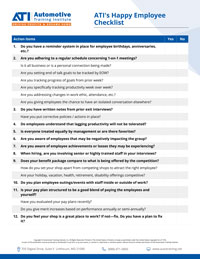Why employees leave managers, not shops
“Hey, Boss, can we talk in your office for a minute?” As a shop owner, this statement will make a flurry of thoughts enter your mind. Is there a vacation request coming? Is there a shop efficiency recommendation being made? Do we need a new latest and greatest tool that will benefit everyone? Wait…deep breath…. am I about to lose someone?
When the door closes on your office, and you both take a seat, you don’t need words to explain what’s about to happen. The body language from your soon-to-be ex-employee, Hank, is something you recognize from talks in your office in the past. You’ve been here before but didn’t see it coming this time. “I thought Hank was happy here,” you think. “I’ve treated him so well.” Initially to break the ice, Hank makes a comment about how great it’s been, and how it’s not something specific. However, in his mind it is specific, and you missed what’s been transpiring in his life for months. He ends with giving you the “…so two Fridays from now will be my last day here.”
Limited Time Offer: ATI's Happy Employee ChecklistThis checklist provides easy tips that shop owners can do today to increase employee retention and engagement. To receive your copy of ATI's Happy Employee Checklist to use in your shop, go to www.ationlinetraining.com/2021-06 for a limited time.
What's really wrong
In this scenario, Hank is a hardworking, does-what-he’s-told, productive member of your staff. Regardless of what you think was the motivation for Hank to move on, your knee-jerk reaction will be to salvage this conversation and persuade him to stay. You can only do this effectively if you handle the conversation as an exit interview, without allowing Hank to think you’re OK with his decision to leave. Asking questions about his mindset and what he found beneficial elsewhere are the only ways to tackle his objections, or realistically, at least find out what you didn’t know: why isn’t he satisfied with what your shop provides? What aren’t you offering to keep valuable employees? What if Hank’s answer isn’t about those things at all? Instead, Hank said, “I’ve had enough of Ted. I warned you that he’s making it tough to work here!”
We’ve all heard the cliché of how a cancer in the shop spreads. The effect of Ted cannot be understated. Ted thinks he’s better than others, refuses to do certain work, manipulates the schedule to his advantage, takes excessive breaks, and doesn’t follow standardized rules. This is a hardship and frustration felt by all. But one thing you didn’t see past your frustrations with Ted is your staff knows you’re the one letting it happen. They may or may not say it, but they know it. How to handle a “Ted” is different on a case-by-case basis. How quickly to fix Ted, however, must have an immediate timetable to it. I used a name in this example, because most likely, you’ve renamed him as you read this.
The warning signs
After Hank leaves the office, you start thinking about what you could have done to predict this talk coming your way. You remember seeing a drop-off in his productivity a few months back that never really recovered. Sure, you had talks about it, and pointed out things that Hank could’ve done better, but he never really recovered when compared to what he used to produce in years past. He also started showing up late, when you used to use him as an example for others to follow when it came to work ethic. Maybe you were blinded by these changes because of a drop in car count, an efficiency change in everyone shop-wide, or maybe something you missed.
You remember it’s been weeks since you’ve held one-on-one meetings, but that’s because you’ve been busy. Initially you were doing them on schedule at an exact interval, but the appeal and effectiveness wore off after you felt the sit-downs got redundant. You remember Hank’s dad had a medical emergency midsummer, but you didn’t follow up with him as to how his dad was doing. You also remember that his dealership buddy, with whom he used to speak only when a technical problem came up, started showing up at the shop out of nowhere on a regular basis. Even if you pressed Hank for answers when he gave you the two weeks’ notice, the effects of what he felt were too strong and too long-lasting to overcome now. This scenario is now at a point of no return.
How to keep employees engaged
As a leader, you should know your team’s satisfaction level in their personal lives, because we all know those shortcomings can sometimes spill into our professional lives. Not to mention that it is a necessary tactic to control situations like this. If your environment is a punch-in, punch-out kind of place, the engagement level from your employee is going to be predictably low, and because of that low engagement, their days at your shop are surely numbered. What can you do to connect on a higher level with everyone both as a team and at an individual level? Let’s see what options we have.
Let’s start at the beginning of an employee’s relationship with the employer. At the time of an interview, an opening statement like “it’s best for both of us to be honest with each other, so there’s no surprises later” sets a precedent of honesty and clear communication from the get-go. You should have already done your preliminary research on the candidate through their resume and social media presence, among other things. If they prepared properly, they researched you and your company as well. In the initial or subsequent interviews, you will discuss pay scale, hours of operation, and expectations. But what about what’s in it for them — benefits?
Beyond what employees believe are the bare necessities in comparing prospective employers — health insurance, retirement savings, holidays off, vacation — there’s one large factor: what’s the environment like? Hopefully, you know the answer to this question before posting a “help wanted” ad. What is your leverage versus other shops hiring? Meaning, what sets you apart and makes you more appealing than what every other shop is providing? Unless you were creative in making the ad to the point where candidates were surprised by what they read, from the applicant’s viewpoint, almost all ads look the same.
Hopefully, you have examples of what sets you apart from the crowd and are eager to explain to a possible candidate these differences during the interview. Lunches every Friday where the employees have a chance to contribute meaningful, more efficient ways to go about business (not gripe about the last customer or any other negative circumstance). Last month you all went bowling together and divided into two teams, where everyone wins, and team growth is maximized. When arranging the team-building events, you let the employees pick where they’re going, because allowing employees to brainstorm and then vote on what event they would like raises their level of engagement. Oh, don’t forget you recently cleared out an unused area within the building and now it houses exercise equipment (and maybe you even built in a shower!). The are many examples, but unless they happened, the benefits of working with you may be outshined by a shop down the road.
Moving on to existing employees, shame on you if you didn’t follow up on the condition of their family member who recently had a medical emergency. Shame on you if you didn’t give them their birthday off, celebrate their tenure anniversary, or send their daughter or son a congratulatory card on their recent graduation. Don’t think for a minute that when that employee is griping at home about their job and possibly going elsewhere, that their spouse isn’t going to remind them of all the personal touches you’ve extended and how much you care about not just the employee, but their family as well. The engagement will extend not only to the person you work alongside everyday, but to those they share their personal lives with. Going above and beyond is what makes the connection to our inner customer stronger, not just transactional.
So, you did the team-building exercises, gave Hank his birthday off with a gift waiting for him at home, and he takes showers at work before heading out for the day. How come he still sat you down and gave you the dreaded news? An employer’s inherent way of thinking will almost always point to pay deficiencies first. But it’s a known fact that employees don’t leave an employer to gain a dollar down the road; there are bigger factors at play. Nothing beats an honest conversation between two people when you don’t allow inclusion of rank or background. If your employee’s demeanor, work ethic, and body language have changed, what outside factors might have caused that? You won’t know unless you ask.
There are personalities out there that don’t share their personal problems easily in a social environment. Sometimes as a leader, you have to be persistent, but in a careful way. There are also factors you can’t control — relocation for any number of reasons, issues at home, a death in the family, to name a few. The best you can do is navigate these with a personal touch. In these examples, you’re doing these things as a friend, not as an employer. In the end, it’s possible that the shoulder you provided for them to lean on may be what was needed for them to get through those tough times.
Last, and probably the easiest to remedy, are shortcomings on your pay plan. Only if you’re operating your business with the latest best practices will you have the room to adjust these pay plans and pay scales for your employees if you do find yourself not competitive in your area. If the shortage on your end isn’t one dollar, but something that is noticeably less than your competition, be proactive in the change. See what’s out there. Look at your competition’s want ads. Take it a step further — go on some interviews at your competitors. This may sound drastic, but you will get your eyes opened for you. You’ll get first-hand knowledge of things that have changed in the industry because you’ve been busy being an owner for years. Benefit packages, pay plans, system processes, are all there for your picking! Each and every day you should be doing things from an outside-the-box thought process — “It’s hard to see the big picture, when you’re stuck in the frame.”
Put the plan in place
Hank is gone now, and you’ll have to get his replacement in the door pronto. Now you are forced to reflect on the shortcomings you have as an employer and should have changes in motion to correct those problems. Now the way you look at treating and keeping your employees is different. Now the way you conduct the interview process is different. Now we just have to find the right replacement, which begs the question — what’s your bench looking like?
To help you answer these questions, increase employee retention and build engagement, get ATI's Happy Employee Checklist at www.ationlinetraining.com/2021-06 for a limited time.






